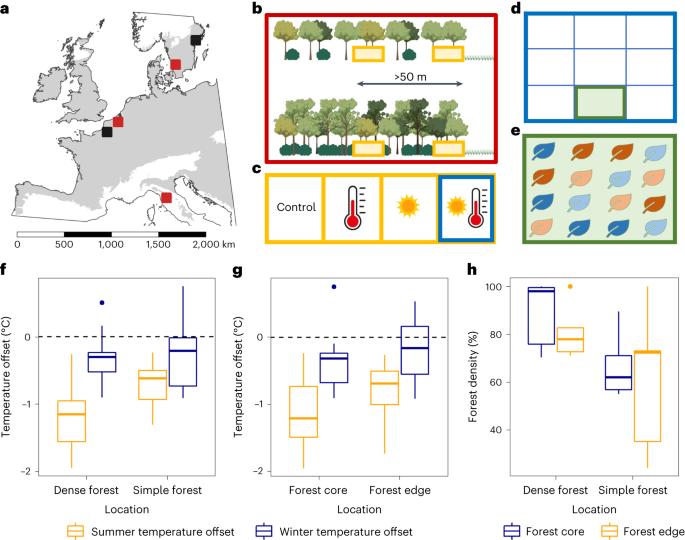气候变化下小气候和森林密度驱动植物种群动态
IF 29.6
1区 地球科学
Q1 ENVIRONMENTAL SCIENCES
引用次数: 1
摘要
宏观气候变化正在影响全球生态系统。然而,很大一部分陆地物种生活在宏观气候变化的影响得到缓冲的条件下,如树荫下,这种缓冲作用如何影响未来大陆尺度的树冠下生物多样性重新分布尚不清楚。在这里,我们展示了浓密树冠带来的林地阴凉可以减轻气候变暖对森林生物多样性的严重影响,而树冠开放则会放大宏观气候变化的影响。我们在五个生物地理环境截然不同的地区进行了跨大陆移植实验,结合实验性加热和辐照处理,将 25 米分辨率的机理人口分布模型参数化,并预测了 12 种常见林下植物的当前和未来分布,同时考虑了森林小气候和森林植被密度的影响。这些结果突出表明,小气候和森林密度是森林管理者和政策制定者保护森林生物多样性免受气候变化影响的有力工具。人们对小气候对未来植物种群动态的影响知之甚少。作者利用大规模移植气候变化实验,展示了森林微气候对种群动态的影响,并预测了 12 种常见林下植物的分布。本文章由计算机程序翻译,如有差异,请以英文原文为准。

Microclimate and forest density drive plant population dynamics under climate change
Macroclimatic changes are impacting ecosystems worldwide. However, a large portion of terrestrial species live under conditions where impacts of macroclimate change are buffered, such as in the shade of trees, and how this buffering impacts future below-canopy biodiversity redistributions at the continental scale is unknown. Here we show that shady forest floors due to dense tree canopies mitigate severe warming impacts on forest biodiversity, while canopy opening amplifies macroclimate change impacts. A cross-continental transplant experiment in five contrasting biogeographical areas combined with experimental heating and irradiation treatments was used to parametize 25-m resolution mechanistic demographic distribution models and project the current and future distributions of 12 common understorey plant species, considering the effects of forest microclimate and forest cover density. These results highlight microclimates and forest density as powerful tools for forest managers and policymakers to shelter forest biodiversity from climate change. The impacts of microclimate on future plant population dynamics are poorly understood. The authors use large-scale transplant climate change experiments to show the contribution of forest microclimates to population dynamics and project the distributions of 12 common understorey plants.
求助全文
通过发布文献求助,成功后即可免费获取论文全文。
去求助
来源期刊

Nature Climate Change
ENVIRONMENTAL SCIENCES-METEOROLOGY & ATMOSPHERIC SCIENCES
CiteScore
40.30
自引率
1.60%
发文量
267
审稿时长
4-8 weeks
期刊介绍:
Nature Climate Change is dedicated to addressing the scientific challenge of understanding Earth's changing climate and its societal implications. As a monthly journal, it publishes significant and cutting-edge research on the nature, causes, and impacts of global climate change, as well as its implications for the economy, policy, and the world at large.
The journal publishes original research spanning the natural and social sciences, synthesizing interdisciplinary research to provide a comprehensive understanding of climate change. It upholds the high standards set by all Nature-branded journals, ensuring top-tier original research through a fair and rigorous review process, broad readership access, high standards of copy editing and production, rapid publication, and independence from academic societies and other vested interests.
Nature Climate Change serves as a platform for discussion among experts, publishing opinion, analysis, and review articles. It also features Research Highlights to highlight important developments in the field and original reporting from renowned science journalists in the form of feature articles.
Topics covered in the journal include adaptation, atmospheric science, ecology, economics, energy, impacts and vulnerability, mitigation, oceanography, policy, sociology, and sustainability, among others.
 求助内容:
求助内容: 应助结果提醒方式:
应助结果提醒方式:


